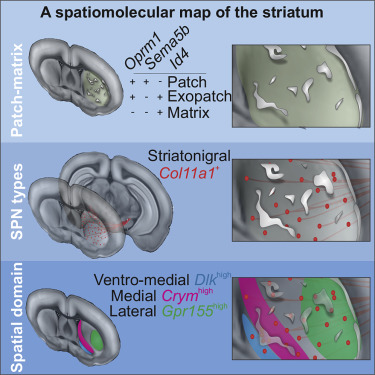Our official English website, www.x-mol.net, welcomes your
feedback! (Note: you will need to create a separate account there.)
A Spatiomolecular Map of the Striatum.
Cell Reports ( IF 7.5 ) Pub Date : 2019-12-24 , DOI: 10.1016/j.celrep.2019.11.096 Antje Märtin 1 , Daniela Calvigioni 1 , Ourania Tzortzi 1 , Janos Fuzik 1 , Emil Wärnberg 1 , Konstantinos Meletis 1
Cell Reports ( IF 7.5 ) Pub Date : 2019-12-24 , DOI: 10.1016/j.celrep.2019.11.096 Antje Märtin 1 , Daniela Calvigioni 1 , Ourania Tzortzi 1 , Janos Fuzik 1 , Emil Wärnberg 1 , Konstantinos Meletis 1
Affiliation

|
The striatum is organized into two major outputs formed by striatal projection neuron (SPN) subtypes with distinct molecular identities. In addition, histochemical division into patch and matrix compartments represents an additional spatial organization, proposed to mirror a motor-motivation regionalization. To map the molecular diversity of patch versus matrix SPNs, we genetically labeled mu opioid receptor (Oprm1) expressing neurons and performed single-nucleus RNA sequencing. This allowed us to establish molecular definitions of patch, matrix, and exopatch SPNs, as well as identification of Col11a1+ striatonigral SPNs. At the tissue level, mapping the expression of candidate markers reveals organization of spatial domains, which are conserved in the non-human primate brain. The spatial markers are cell-type independent and instead represent a spatial code found across all SPNs within a spatial domain. The spatiomolecular map establishes a formal system for targeting and studying striatal subregions and SPNs subtypes, beyond the classical striatonigral and striatopallidal division.
中文翻译:

纹状体的空间分子图。
纹状体被组织成由纹状体投射神经元(SPN)亚型形成的两个主要输出,这些亚型具有不同的分子身份。另外,组织化学划分为斑块和基质区室代表了另外的空间组织,被提议以反映汽车动力区域化。为了绘制膜片对基质SPNs的分子多样性图,我们对表达μμ阿片受体(Oprm1)的神经元进行了遗传标记,并进行了单核RNA测序。这使我们能够建立补丁,基质和外来补丁SPN的分子定义,并鉴定Col11a1 +纹状体SPN。在组织水平上,绘制候选标记的表达图可揭示非人类灵长类动物大脑中保守的空间域的组织。空间标记与单元类型无关,而是表示在空间域内的所有SPN上找到的空间代码。时空分子图谱建立了一个针对和研究纹状体亚区和SPN亚型的正规系统,超越了经典的纹状体和纹状体。
更新日期:2019-12-25
中文翻译:

纹状体的空间分子图。
纹状体被组织成由纹状体投射神经元(SPN)亚型形成的两个主要输出,这些亚型具有不同的分子身份。另外,组织化学划分为斑块和基质区室代表了另外的空间组织,被提议以反映汽车动力区域化。为了绘制膜片对基质SPNs的分子多样性图,我们对表达μμ阿片受体(Oprm1)的神经元进行了遗传标记,并进行了单核RNA测序。这使我们能够建立补丁,基质和外来补丁SPN的分子定义,并鉴定Col11a1 +纹状体SPN。在组织水平上,绘制候选标记的表达图可揭示非人类灵长类动物大脑中保守的空间域的组织。空间标记与单元类型无关,而是表示在空间域内的所有SPN上找到的空间代码。时空分子图谱建立了一个针对和研究纹状体亚区和SPN亚型的正规系统,超越了经典的纹状体和纹状体。


















































 京公网安备 11010802027423号
京公网安备 11010802027423号